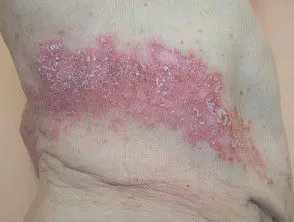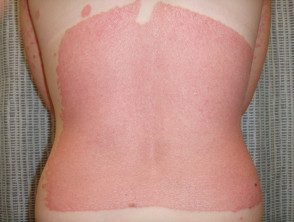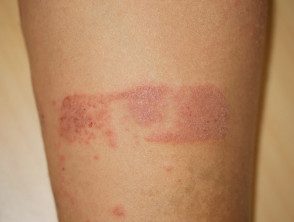Which is the Koebner phenomenon?
The Koebner phenomenon describes the appearance of new skin lesions in areas of cutaneous lesion on healthy skin. It is also known as the Kobner freak and isomorphic reply.
Linear lesions due to Koebner phenomenon in lichen planus
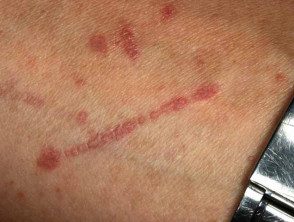
Linear lesions due to Koebner phenomenon in lichen planus

Linear lesions due to Koebner phenomenon in lichen planus
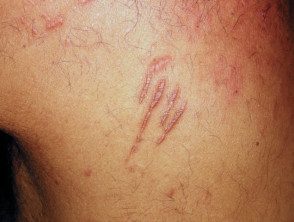
Linear lesions due to Koebner phenomenon in lichen planus
What is the cause of the Koebner phenomenon?
The cause of the Koebner phenomenon is not clear. Current theories suggest that the Koebner phenomenon requires both epidermis and dermis be injured in the same place. The production of inflammatory Substances and neuropeptides have been postulated as a non-specific first step, triggering a specific secondary disease process. The role of chemical messengers such as the nerve growth factor (NGF) can be important.
Under what conditions is the Koebner phenomenon observed?
Skin conditions that regularly manifest Koebner phenomenon include psoriasis, vitiligo, and lichen planus. There have been reports of possible Koebner phenomena in many other conditions.
A true Koebner response occurs at:
- Psoriasis
- Vitiligo
- aura nevus
-
Lichen planus.
A pseudo-Koebner response occurs with infections arising in an area of trauma.
- Molluscum contagiosum
- Warts
Located trauma can also lead to:
-
Behҫet's disease and pgangrenous yoderma (pathergy)
- Cancer, e.g Marjolin ulcer arising in a long standing scar
- Darier's disease
- Erythema multiform
- Granuloma cancel
- Hailey-Hailey disease
- Kaposi sarcoma
- Kyrle's disease
- Lichen sclerosus
- Morph
- Necrobiosis lipoidica
- Pellagra
- perforating folliculitis
-
Perforating reactive collagenosis.
What are the triggers of the Koebner phenomenon?
A variety of skin lesions have been found to trigger the Koebner phenomenon.
Trauma
- Bites: animals, insects.
- Burns: thermal, electrodesiccation, sunburn.
- Excoriation, friction: shaving
- Freezing, cryotherapy
- Lacerations: gunshot, needle stick, surgical incisions
- Pressure: braces, pressure ulcers, thumb sucking, nail manicure
chemical irritation
- A positive patch test reaction
- A skin reaction associated with a tattoo.
- BCG or flu shot
- Hair spray or hair dye allergy
- Tuberculin skin test
-
iodine reaction
Diseases / medical conditions
- Urticaria
- A variety of inflammatory skin disease
Other
-
Phototherapy and sunburn.
- high energy irradiation
- Withdrawal of methotrexate therapy
How is Koebner's phenomenon diagnosed?
Koebner's phenomenon is diagnosed clinically. TCharacteristic lesions:
- Develop at sites of skin injury (such as a scratch), on previously healthy skin
- Have the same clinic and histological features such as lesions of the patient's original skin disease
- They are not due to the seeding of an infectious agent, a allergic reaction to a contact agent, or skin degradation.
Lesions may form in patients with or without pre-existing skin conditions. A true Koebner response can be confirmed by experimental reproduction of lesions with different lesion methods. However, this does not always work and is often not practical or desirable.
Koebner phenomenon lesions are often linear in shape, as they follow the route of skin injury. In addition to linear skin lesions, linear lesions resulting from the Koebner phenomenon can also be seen in mosaic skin disorders (eg, segmental lichen planus).
What are the clinical features of the Koebner phenomenon?
Gradual response to trauma
Patients differ in the intensity with which they respond to skin lesions.
- Maximum Koebner response: Lesions develop over the entire injured area.
- Koebner's minimum response: a injury develops in a focal trauma area.
- Abortive Koebner response: lesions appear, but disappear spontaneously after 12-20 days.
- There is no response from Koebner to the injury.
All or nothing answer
Patients who develop Koebner's phenomenon in response to one method of injury are susceptible to other triggering stimuli. This is particularly observed in patients with psoriasis. In contrast, a patient who does not develop skin lesions with one type of lesion is not expected to develop Koebner's phenomenon with another type of lesion.
Development time of lesions.
The time from injury to the formation of a skin lesion depends on the specific skin disease. for psoriatic plates, is between 10 to 20 days, with a range of 3 days to 2 years. The time of lesion formation may differ in the same patient.
Non-cutaneous Koebner phenomenon
Some reports suggest that the Koebner phenomenon may affect surfaces other than the skin, such as the oral mucous membraneor cause injury to internal organs, such as the lungs after damage caused by chronic infection. Skin lesions due to Koebner phenomenon have been reported in sarcoidosis. and systemic lupus erythematosus.
What other phenomena are associated with skin trauma?
Other phenomena in relation to trauma or skin damage are distinct from the Koebner phenomenon.
- The reverse Koebner phenomenon is the disappearance of a skin lesion after trauma to the area.
- Wolf isotopic response it is the appearance of new lesions in the exact place of previous healed lesions and is not necessarily due to trauma.
- Renbok phenomenon is the disappearance of an existing skin disease after the onset of a new lesion in the same place.
-
Pathergy is an altered tissue reactivity in response to trauma, with the formation of papules or pustules
Koebner phenomenon in psoriasis
Psoriasis is the most researched condition exhibiting the Koebner phenomenon and can be used to aid diagnosis.
The Koebner phenomenon has been observed to be particularly predominant in:
- Unstable psoriasis
- Patients with an early age of psoriasis onset.
- Patients who have received multiple treatments for psoriasis.
- winter compared to summer
- Patients with emotional distress.
Other studies indicate that the Koebner phenomenon:
- ORoccurs less frequently during remission from psoriasis
- It is not related to the severity of the disease; It can occur in mild and severe diseases.
Plaques exhibiting the Koebner phenomenon can appear on any area of the body, even those not usually involved in psoriasis.
In recalcitrant psoriasis, a concurrent skin condition as contact dermatitis can drive the disease through the Koebner phenomenon.
Koebner phenomenon in psoriasis
Can the Koebner phenomenon be prevented?
Although it is not possible to prevent all skin lesions, if you are susceptible to the Koebner phenomenon, take care to avoid:
- Sun tanning
- Contact with irritants
- Scratch
The following have been reported to prevent the Koebner phenomenon:
- Pressure, such as a bandage or pressure bandage.
- Suction, like a vacuum dressing
- A vasoconstrictor, such as adrenaline.
What is the treatment for Koebner phenomenon?
- Elective surgery/procedures are ideally performed while the skin disease is stable or in remission.
- Active systemic treatment of psoriasis can suppress the Koebner phenomenon.
- a bland ointment can be inhibitory but current Corticosteroids have not been shown to prevent Koebner's phenomenon.
Treatment of skin lesions resulting from Koebner's phenomenon depends on the associated skin condition.

